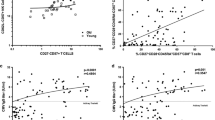Abstract
Natural killer (NK) cells are lymphocytes which can kill tumor and virus-infected cells, and mediate acute rejection of bone marrow grafts. NK-cell killing is directed primarily at target cells which do not express sufficient levels of self-major histocompatibility complex (MHC) class-I molecules. Inhibition of lysis of self-MHC-expressing target cells is mediated via inhibitory receptors on the NK cell, which bind to MHC molecules. Each NK cell expresses only a subset of all its inhibitory receptor gene repertoire, which may bind to only a subset of the self-MHC molecules expressed by other cells of the organism. Two conceptual models have been proposed to explain the process of NK cell ‘education’ in which these cells adapt, during their development, to the self-MHC environment: the two-step selection and the sequential models. In this manuscript we develop mathematical and computational models of the process of NK cell development and education, which implement the two conceptual models. We use this theoretical framework to examine the available data on NK cell repertoire compositions, and evaluate the degree these data support either of the two conceptual models. We show that the data published so far on NK cell receptor expression patterns is insufficient to refute either model, since data on NK cell receptor binding affinities to MHC is also needed. However, the models allow us to make predictions on these binding affinities, which can later be tested experimentally.
Similar content being viewed by others
References
Colonna, M. and J. Samaridis (1995). Cloning of immunoglobulin-superfamily members associated with HLA-C and HLA-B recognition by human NK cells. Science 268, 405–408.
Fahlén, L., U. Lendahl and C. L. Sentman (2001). MHC class I-Ly49 interaction shape the Ly49 repertoire on murine NK cells. J. Immunol. 166, 6585–6592.
Hanke, T., H. Takizawa and D. H. Raulet (2001). MHC-dependent shaping of the inhibitory Ly49 receptor repertoire on NK cells: evidence for a regulated sequential model. Eur. J. Immunol. 31, 3370–3379.
Held, W., J. R. Dorfman, M.-F. Wu and D. H. Raulet (1996). Major histocompatibility complex class I dependent skewing of the natural killer cell LY49 receptor repertoire. Eur. J. Immunol. 26, 2286–2292.
Held, W., B. Kunz, V. Ioannidis and B. Lowin-Kropf (1999a). Mono-allelic Ly49 NK cell receptor expression. Sem. Immunol. 11, 349–355.
Held, W., B. Kunz, B. Lowin-Kropf, M. V. de Wetering and H. Clevers (1999b). Clonal acquisition of the Ly49A NK cell receptor is dependent on the trans-acting factor TCF-1. Immunity 11, 433–442.
Held, W. and D. H. Raulet (1997). Ly49A transgenic mice provide evidence for a major histocompatibility complex-dependent education process in natural killer cell development. J. Exp. Med. 185, 2079–2088.
Höglund, P., H. G. Ljunggren, C. Öhlén, L. Ahrlund-Richter, G. Scangos, C. Bieberich, G. Jay, G. Klein and K. Kärre (1988). Natural resistance against lymphoma grafts conveyed by H-2Dd transgene to C57BL mice. J. Exp. Med. 168, 1469–1474.
Kambayashi, T., J. Michaëlsson, L. Fahlén, B. J. Chambers, C. L. Sentman, K. Kärre and H. G. Ljunggren (2001). Purified MHC class I molecules inhibit activated NK cells in a cell-free system in vitro. Eur. J. Immunol. 31, 869–875.
Kubota, A., S. Kubota, S. Lohwasser, D. L. Mager and F. Takei (1999). Diversity of NK cell receptor repertoire in adult and neonatal mice. J. Immunol. 163, 212–216.
Ljunggren, H.-G. and K. Kärre (1990). In search of the ‘missing self’: MHC molecules and NK cell recognition. Immunol. Today 11, 237–244.
Maenaka, K. et al. (1999). Killer cell immunoglobulin receptors and T cell receptors bind peptide-major histocompatibility complex class I with distinct thermodynamic and kinetic properties. J. Biol. Chem. 274, 28329–28334.
Michaëlsson, J., A. Achour, M. Salcedo, A. Kåse-Sjöström, J. Sundbäck, R. A. Harris and K. Kärre (2000). Visualization of inhibitory Ly49 receptor specificity with soluble major histocompatibility complex class I tetramers. Eur. J. Immunol. 30, 300–307.
Öhlén, C., G. Kling, P. Höglund, M. Hansson, G. Scangos, C. Bieberich, G. Jay and K. Kärre (1989). Prevention of allogeneic bone marrow graft rejection by H-2 transgene in donor mice. Science 246, 666–668.
Raulet, D. H., W. Held, I. Correa, J. Dorfman, M.-F. Wu and L. Corral (1997). Specificity, tolerance and developmental regulation of natural killer cells defined by expression of class I-specific Ly49 receptors. Immunol. Rev. 155, 41–52.
Salcedo, M., A. D. Diehl, M. Y. Olsson-Alheim, J. Sundbäck, L. Van-Kaer, K. Kärre and H. G. Ljunggren (1997). Altered expression of Ly49 inhibitory receptors on natural killer cells from MHC class-I deficient mice. J. Immunol. 158, 3174–3180.
Smith, H. R. C., H. H. Chuang, L. L. Wang, M. Salcedo, J. W. Heusel and W. M. Yokoyama (2000). Nonstochastic coexpression of activation receptors on murine natural killer cells. J. Exp. Med. 191, 1341–1354.
Vance, R. E. and D. H. Raulet (1998). Toward a quantitative analysis of the repertoire of class I MHC specific inhibitory receptors on natural killer cells. Curr. Top. Microbio. Immunol. 230, 135–160.
Yokoyama, W. M., P. J. Kehn, D. I. Cohen and E. M. Shevach (1990). Chromosomal location of the Ly-49(A1, YE1/48) multigene family genetic association with the NK1.1 antigen. J. Immunol. 145, 2353–2358.
Author information
Authors and Affiliations
Corresponding author
Rights and permissions
About this article
Cite this article
Salmon-Divon, M., Höglund, P. & Mehr, R. Generation of the natural killer cell repertoire: The sequential vs. the two-step selection model. Bull. Math. Biol. 65, 199–218 (2003). https://doi.org/10.1016/S0092-8240(02)00093-9
Received:
Accepted:
Issue Date:
DOI: https://doi.org/10.1016/S0092-8240(02)00093-9




